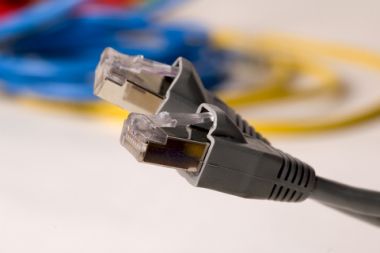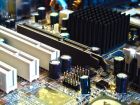Network Ports
Can I connect to the net with this port?
In this section we will discuss network ports, what they are and how to use it.
Networking, in general, is quite a broad subject but I will try to keep it simple and to the point.
It's really not that complex to understand and you need not be an expert to connect a network cable and use it.
The Basics
You use a network port to connect your computer to a, well, network. A network is basically a collection of computers that share information between them.
If you connect a router, you can also connect to the internet. So, you and the other users can share information between each other and connect to the internet.
The most common protocol used today to transmit data over the LAN (Local Area Networks) is called, Ethernet.
Ethernet is a set of standards that defines how data is transmitted over the physical cabling from one device to another.
There are other protocols such as token ring, but Ethernet is by far the most popular.
You connect a cable with a RJ45 connector. RJ45 is a standard that defines the physical connector and wiring pattern used by the cable. "RJ" is short for, Registered Jack.
It's quite common and most PC shops will sell this cable. You just have to ask the sales guy for a network cable.
RJ45 connectors
There is much confusion over what RJ45 defines. Just to confuse you more, here is the typical naming for a normal network cable:RJ45 100BASE-T CAT5 UTP
Huh, say what?.
Yep, I know, it even confuses me sometimes.
People commonly refer to the RJ45 as the physical connector. They refer to it as the actual dimensions of the jack. In fact the RJ designation refers to the wiring pattern and not the physical geometry of the connector.
The 100BASE-T refers to the Ethernet standard that defines the speed over a specific type of cable. In this example the 100 in 100BASE-T refers to 100Mbits/second.
CAT5 is the cable type. CAT5 uses four pairs of cables that are twisted.
The UTP meaning Unshielded Twisted Pair means that the wiring is unshielded but twisted in pairs to reduce interference in the signal.
Don't sweat all the terminology!
The most common network cable is just referred to as a network cable. Engineers who specialize in networks need to know all the jargon that goes with it.
How do I connect to a network or network ports?
If you want to connect only 2 computers together, you just take a network cable, and plug it into each network port on the PC or Laptop.
IF you want to connect more than two computers together, you must use a hub or switch. The most common method is to use switches.
Hubs are still used but switches has become so cheap that most people use switches.
So, whats the difference between hubs and switches?
Hubs share the bandwidth between all it's ports. For instance, if you have a 100Mbit/second hub, then all the devices you plug in the hub shares the 100Mbit bandwidth. So, the more devices you plug in the slower your network will get.
Well, sort off. It all depends on how busy the devices are. If all the devices plugged into the hub are busy sending data, then the network will be slow.
Switches does not share the bandwidth. Each port on the switch operate at the advertised bandwidth. If you buy a 100Mbits/second switch, then each port can transfer 100Mbits/second. Switches are also more intelligent than hubs. It can remember what device is plugged on which port to help with routing.
Small 5 port switch
The switch in the above picture is typically used in small networks. It only has 5 ports, so 5 computer can be connected together. One of the ports may be used to connect to a router.
Routers are normally setup by the service provider that you bought the router from. They will install it and configure it to connect to the internet. Of course you can also do it yourself, but if you are unfamiliar with routers then rather let the pro's do it.
Physically, hubs and switches, look very similar. You will probably need to look at the model numbers or documentation to distinguish which is which.
It's very simple to connect computers to a network using switches. You just plug a network cable into the PC's network ports and connect the other side of the cable to a switch or hub.
Then it's up to the software or operating system to connect the systems.
What is an IP Address?
An IP (Internet Protocol) address is used to identify a computer on the internet. It is unique and is made up by a 4 dotted decimal numbers. A typical IP address is, 192.168.2.3
There are four numbers in an IP address. Each number is a byte, so a IP address basically consists of 4 bytes or 32 bits.
There are different classes of networks. The most common classes are, class A, B and C. The IP is made up of a network number and a host number. The classes depicts which of these bits are network and which are host.
Routers are usually setup as DHCP (Dynamic Host Control Protocol) hosts. This means that when you power your computer on, the router will automatically assign an IP address to your computer.
You then open your browser and connect to the internet.
If you have a small group of computers that just connect to each other, then you don't need to worry about IP addresses. You can use the stock standard tools that comes with windows to connect and share information between systems.
Network and network ports could be quite complex. I have only touched on the basics of what networks really are. I can easily create a whole web page on networks and network ports.
You will probably only connect your PC to your service providers router or to a USB modem to gain access to the net. You don't really need to know all the info up to bit and byte level to do this.
Return from Network ports to Computer Ports
Back to What is My Computer



